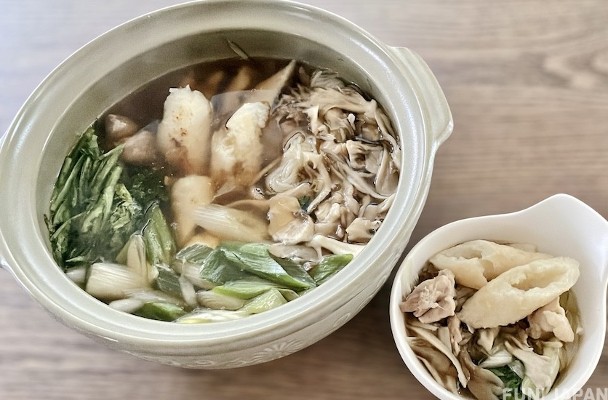Introduced in Japanese Local Cuisine Reproduction Series this time is kiritanpo nabe (きりたんぽ鍋), a local dish of Akita Prefecture. The chicken and burdock soup stock soaks into the chewy kiritanpo rice sticks, making it a delicious dish that warms the body, not to mention the refreshing and appetizing scent of chrysanthemum greens! In this article, I will show you how to make kiritanpo nabe at home. Read on to watch the cooking video!
What is Japanese local cuisine?
Local cuisine (郷土料理 / Kyodo-ryouri) refers to dishes suitable for the climate that have been eaten in a local area for many years by using regional products. Many of them are comfort food and are popular among Japanese for domestic gourmet trips.
Origin of kiritanpo nabe

For those wondering what a kiritanpo (きりたんぽ) is, let's learn about its basis. Kiritanpo is made by mashing rice with a pestle, attaching it to a stick that serves as the core, and then grilling it. Kiritanpos mixed in a pot is called kiritanpo nabe (きりたんぽ鍋).
This kiritanpo nabe is a local dish of Akita Prefecture that was selected as one of the 100 Best Local Dishes (農山漁村の郷土料理百選) by the Ministry of Agriculture, Forestry and Fisheries.
Kiritanpo is said to have originated in the old days when hunters (マタギ / matagi) who hunted in winter started carrying it as a preserved food.
Odate and Kazuno areas of northern Akita Prefecture are said to be the birthplace of kiritanpo. The custom of gathering around a kiritanpo nabe after harvesting new rice such as "Akitakomachi" and appreciating the hard work of farming has been continued even to this day.
In schools in Akita Prefecture, kiritanpo is served as part of the school lunch menu during the winter season and is very popular too.
Characteristics of kiritanpo nabe
Kiritanpo nabe is often made after the new rice is harvested. In northern Akita Prefecture, after the harvest of the new rice is finished every year, people gather around the "kiritanpo nabe" to appreciate the hard work of the harvest. In Odate, it is a dish that has been passed down from generation to generation in each household. Meanwhile, such hot post dish is also an indispensable dish for entertaining guests and is often served at ceremonial occasions.
Ingredients for kiritanpo & kiritanpo nabe (for 2 servings)
Ingredients for kiritanpo:
- Rice (warm) 400g
- Water Appropriate amount
Ingredients for kiritanpo nabe:
- Chicken thigh (cut into bite size pieces) 200g
- Scallions (white part) 2 stalks
- Maitake mushrooms 100g
- Burdocks 100g
- Water (for soaking) Appropriate amount
- Chrysanthemum greens / Shungiku 50g
- Noodles konjac 120g
- Water 800ml
- Chicken stock powder 1 tablespoon
- Soy sauce 3 tablespoon
- Cooking sake 4 tablespoon
- Mirin 2 tablespoon
How to make - with video
- To make kiritanpo, first put the rice in a mortar (or a large bowl if you don't have one) and mash it with a pestle. When about half of the rice grains are left and sticky, wet your hands and shape into 3 bales.
- Grab the bales from #1 and skewer them from the top to the bottom with chopsticks. Wet your hands with water while shaping the dough. Leave about 3 cm below the disposable chopsticks untouched.
- Cook in a frying pan over medium heat for about 20 minutes while rolling them. When their surface is lightly browned, remove from heat.
- Remove the kiritanpo from the chopsticks while it is still hot. Hold the kiritanpo with a dry cloth and gently pull it out while pressing the bottom part of the chopsticks. When it is cooled down, cut it diagonally into 3 equal parts.
- Slice the burdocks into small pieces. Soak in water for about 5 minutes, and drain.
- Cut the scallions diagonally into 2cm lengths. Remove the stalks from the maitake mushrooms and loosen them into small bunches.
- Cut the chrysanthemum greens into 3cm lengths.
- Put water, burdocks and chicken in a clay pot, add chicken stock powder and mix lightly. Cover and cook over medium heat. Once boiling, open the lid, remove the scum, add sake, soy sauce, mirin, and #4 and #6, then cover again. After all, simmer over medium heat for about 5 minutes.
- Add #7 on medium heat and bring to a boil for a while.


Comments